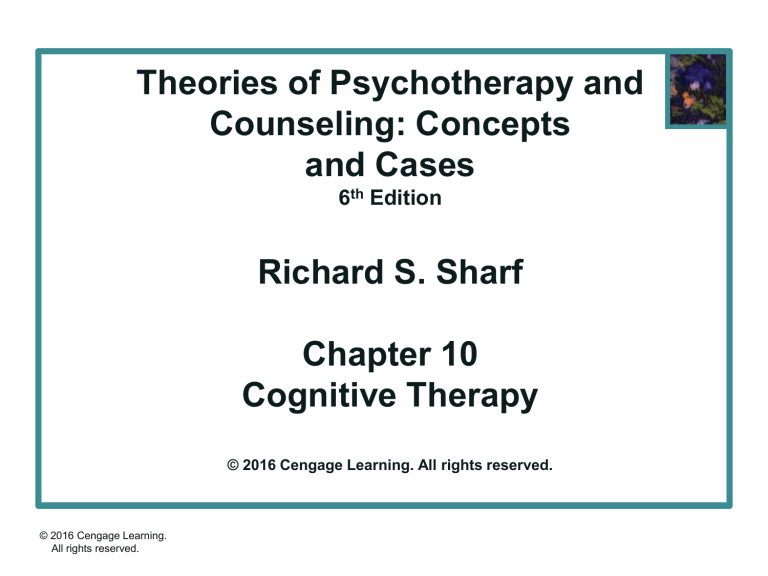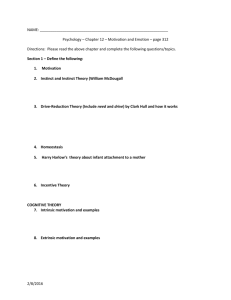
Theories of Psychotherapy and
Counseling: Concepts
and Cases
6th Edition
Richard S. Sharf
Chapter 10
Cognitive Therapy
© 2016 Cengage Learning. All rights reserved.
© 2016 Cengage Learning.
All rights reserved.
Influences on Beck's
Development of Cognitive Therapy
Sigmund Freud
-
unconscious thoughts
anger can be internalized into
depression
Alfred Adler
-
cognitive nature of individuals
active therapeutic approach
Albert Ellis
-
focus of belief systems
challenging inaccurate
assumptions
George Kelly
-
dichotomous personal constructs
Jean Piaget
-
cognitive development
Cognitive science
-
models of mental functioning
Slide 1 Chapter 10
© 2016 Cengage Learning.
All rights reserved.
Important Constructs in the
Cognitive Theory of Personality
Childhood development of beliefs- Long standing views of self
and world develop
Automatic thoughts- Ideas or thoughts that occur without
effort or choice and may lead to emotional responses
Cognitive schemas- Ways of thinking that comprise a set of
core beliefs and assumptions about self and the world
Slide 2 Chapter 10
© 2016 Cengage Learning.
All rights reserved.
Ways in Which Individuals
Distort Their Thinking
•All-or-nothing thinking- black or
white thinking
•Selective abstraction- selecting
one fact and ignoring others
•Mind reading- belief that we
know what another person is
thinking
•Negative prediction- belief that
something bad may happen
•Catastrophizing- exaggerating
possible consequences of an
event
Slide 3 Chapter 10
© 2016 Cengage Learning.
All rights reserved.
•Overgeneralization- applying
rules broadly
•Labeling and mislabelingnegative view based on errors
one has made
•Magnification- An
imperfection is exaggerated
•Minimization- A positive
event becomes less important
•Personalization- An event is
related to oneself when there
is no relationship
Goals of Cognitive Therapy
Remove biases and distortions in thinking to produce more
effective functioning
Produce positive feelings, behavior, and thinking
Specify goals clearly and concretely
Prioritize goals and develop them in collaboration with the
client
Slide 4 Chapter 10
© 2016 Cengage Learning.
All rights reserved.
Assessment in
Cognitive Therapy
Assessment is specific and continues throughout therapy
Interviews - frequent questions
Self-monitoring of thoughts, feelings, and behavior outside the
office
Use of the Dysfunctional Thought Record
Thought sampling
Scales and questionnaires - such as
Beck Depression Inventory
Scale for Suicide Ideation
Dysfunctional Attitude Scale
Slide 5 Chapter 10
© 2016 Cengage Learning.
All rights reserved.
Process of Making Therapeutic
Changes in Cognitive Therapy
•
Guided discovery (Socratic dialogue)
•
Three-question technique
1. What is the evidence for the belief?
2. How else can you interpret the situation?
3. If it is true, what are the implications?
•
Specifying automatic thoughts
•
Assigning homework
•
Termination and relapse issues
Slide 6 Chapter 10
© 2016 Cengage Learning.
All rights reserved.
Methods for Changing Cognitive
Distortions
•
•
•
•
•
•
•
•
Understanding idiosyncratic meaning- Understand words clients
use as related to their automatic thoughts and cognitive schemas
Challenging absolutes- Point out exaggerations such as
“everyone”, “always”, and “never” to client
Reattribution- Help clients place responsibility appropriately for an
event
Labeling of distortions- Point out when client is distorting a thought
or event
Decatastrophizing- “What if” technique is used to point out actual
rather than feared events
Challenging all-or-nothing thinking- Use scaling to turn a dichotomy
into a continuum
Listing advantages and disadvantages- Write down advantages and
disadvantages
Cognitive rehearsal- Use constructive imagination for new events
Slide 7 Chapter 10
© 2016 Cengage Learning.
All rights reserved.
Types of Cognitive Distortions
and Strategies to Change Them
Distortions
Change Strategies
All-or-nothing thinking
Challenging all-or-nothing thinking
Selective abstraction
Mind reading
Negative prediction
Catastrophizing
Decatastrophizing
Labeling and mislabeling
Labeling of distortions
Magnification
Minimization
Personalization
Understanding idiosyncratic meaning
Reattribuiton
Varied distortions
Challenging absolutes
Listing advantages and disadvantages
Slide 8 Chapter 10
© 2016 Cengage Learning.
All rights reserved.
Cognitive rehearsal
Cognitive Therapy Concepts Used
in Treating Depression
Cognitive triad - a depressed person's negative
view of
oneself
the world
one's future
resulting in a variety of cognitive distortions
Slide 9 Chapter 10
© 2016 Cengage Learning.
All rights reserved.
Psychological Disorders:
Examples of Cognitive Therapy
Disorders
Therapist
Patient
Depression
Liese & Larson (1994)
Paul
Anxiety
Freeman et al. (1990)
Amy
Obsessive
Wells (1997)
Electrician
Substance abuse
Beck et al. (1993)
Bill
Slide 10 Chapter 10
© 2016 Cengage Learning.
All rights reserved.
Cognitive Methods Used in
Treating Case Examples
Disorder
Patient
Methods
Depression
Paul
Socratic, three question,
DTR
Anxiety
Amy
Socratic, decatstrophizing
Obsessive
Electrician
Socratic, defusing thoughts
from actions
Substance
Abuse
Bill
Socratic, three questions
Practicing control beliefs
Slide 11 Chapter 10
© 2016 Cengage Learning.
All rights reserved.
Current Trends in
Cognitive Therapy :
Mindfulness based stress reduction: Group program
Schema-focused cognitive therapy for individuals with
personality disorders. Typical schemas:
Abandonment/Instability
Mistrust/Abuse
Emotional deprivation
Defensiveness/Shame
Social isolation/Shame
Developing treatment manuals to work with a wide variety
of disorders such as personality disorders and
schizophrenia
Slide 12 Chapter 10
© 2016 Cengage Learning.
All rights reserved.
Gender Issues and
Cognitive Therapy
Bem's gender schema view
Issues with depressed women
Collaboration - encourage woman's power
Support client beliefs and values as well as challenge
distorted beliefs
Issues with gay men
Learn about sexual orientation
Challenge assumptions about sexuality and sexual roles
Counter misinformation about being gay
Role play "coming out"
Deal with shame issues
Slide 13 Chapter 10
© 2016 Cengage Learning.
All rights reserved.
Multicultural Issues and
Cognitive Therapy
Cultural schemas - cultural beliefs and values
Cognitive therapy's practical and active approach
may help to counteract negative stereotypes about
therapy.
Educational focus of therapy may have wide appeal.
Application to African-Americans, Latinas, Latinos,
and Native Americans
Slide 14 Chapter 10
© 2016 Cengage Learning.
All rights reserved.



